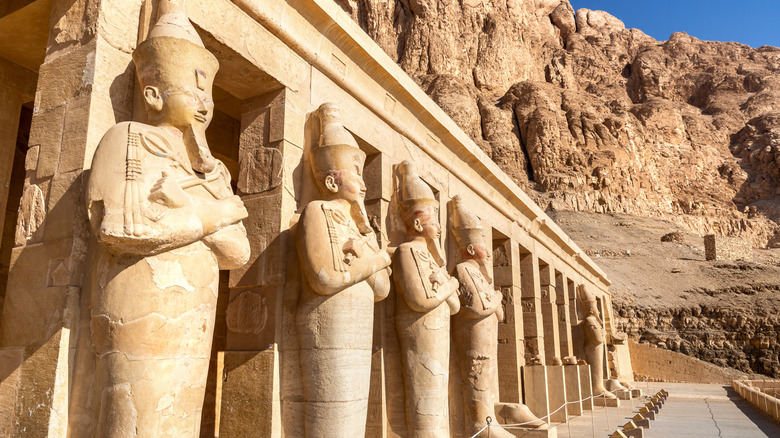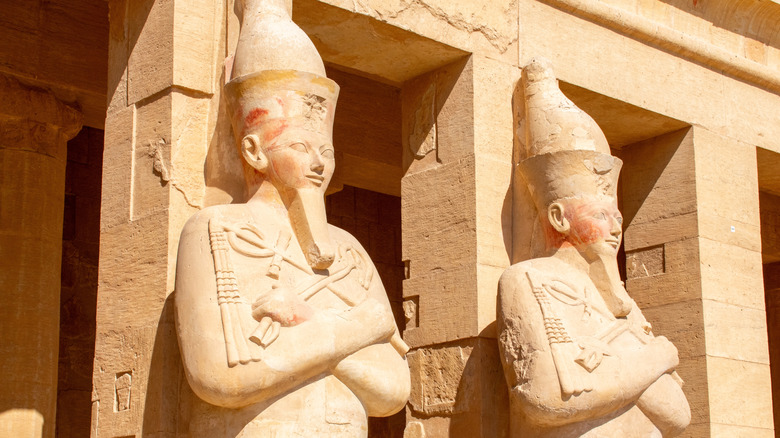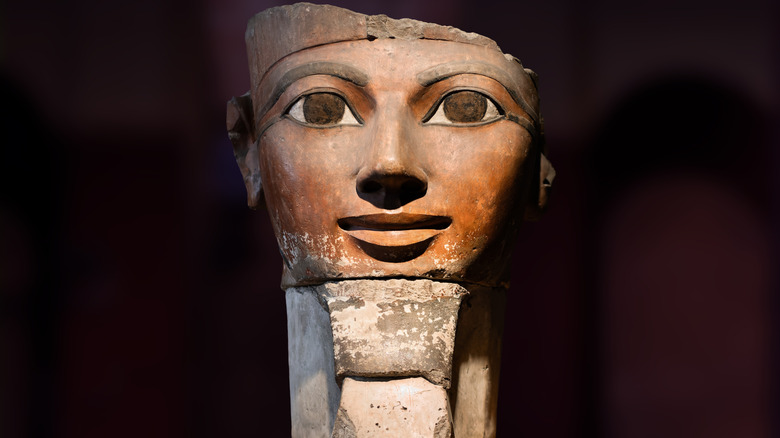How Many Egyptian Pharaohs Were Women?
Immortalized in Shakespearean prose, literature, and on-screen film portrayals, Cleopatra is arguably the most famous female ruler in Egyptian history, followed by Queen Nefertiti and Queen Hatshepsut. Wielding their power from the throne in an era largely dominated by patriarchal rulers (not that much has changed in modern times), these ancient Egyptian baddies weren't the only matriarchs to triumph in the Pharaonic Era. Though you might be quick to assume you know what life was really like for women in Ancient Egypt, the truth is that women actually had a significant amount of power, starkly contrasting with the way other societies operated at the time (such as ancient Greece).
According to the World History Encyclopedia, "women in Ancient Egypt had greater rights than in any other civilization of the time," possessing the right to own land and business, have abortions, get drunk, initiate divorce, and ascend to positions of power like that of the pharaoh. So, just how many female pharaohs were there? According to Arcadia, the exact number is up for debate due to a "lack of written evidence." But in an article published by Hamilton College, Egyptologist Joann Fletcher estimated a total of 12 female pharaohs in ancient Egyptian history — or shall we say her-story?
Famous female pharaohs
When highlighting the famous female pharaohs of ancient Egypt, Cleopatra is an obvious place to start. Born in 69 B.C., she inherited the throne following the death of her father, Ptolemy XII Auletes, when she was just 18 years old. She briefly ruled alongside her younger brother before dropping his name from official documents and taking the kingdom into her own hands.
The last monarch of Egypt before it became a province of Rome, Cleopatra reigned the Ptolemaic Dynasty for 21 years of her short 39-year life. In addition to her political prowess, she is renowned for her wild love life, which included marriages to her two younger brothers, as well as high-powered relationships with Roman rulers Julius Caesar and Marc Antony. Notably, she married the latter after luring him out of his previous marriage with a pageantry-like seduction dressed as Venus, the goddess of love.
Another illustrious female Egyptian pharaoh was Hatshepsut. She became the queen of Egypt at the tender age of 12 by marrying her half brother, Thutmose II, who inherited the throne in 1492 B.C. following the death of their father, Thutmose I. When Thutmose II died, the throne defaulted to his infant son, with Hatshepsut acting as regent until he came of age.
In a rather ballsy power grab, Hatshepsut ultimately attained the full title and powers of a pharaoh herself. Regarded as the "female king of Egypt," she is artistically depicted in paintings and statues as a masculine figure wearing a kilt, a head-cloth, and a false beard — the traditional regalia of a male pharaoh. Preceding Cleopatra's reign by about 14 centuries, she was the first woman to exercise the full powers of her position in ancient Egyptian history, blazing the trail for future female pharaohs.
Forgotten female pharaohs
While some female pharaohs are household names, others (whose names don't always roll off the tongue) don't get nearly as much recognition. As is the case with Egypt's first female pharaoh, Sobekneferu. She was the last ruler of the 12th Dynasty, coming to power after the death of her father, Amenemhet III, and her half brother. Reigning as a pharaoh for just four years, her image is similar to that of Hatshepsut with her statues depicting her dressed in male regalia and striking masculine poses. According to Ancient Origins, Sobekneferu's name derives from the crocodile god Sobek, translating to "she who shows the beauty of the Sobek" and inspiring her nickname, the Crocodile Queen of Egypt. Not much else is known about Egypt's first female pharaoh, as the circumstances of Sobekneferu's death were never recorded, leaving a thick veil of mystery surrounding her existence.
Even less is known about Queen Merneith, whose name translates to "the beloved Neith," per Egypt Today. She is believed to have ruled Egypt for nearly a decade following the death of her husband, King Djet. According to Livius, Mereneith lived during the Early Dynastic Period, and has two royal tombs: One in Abydos, the other in the modern day city of Memphis (no, not that Memphis). Though archaeologists initially believed Mereneith's second tomb belonged to a male king, a seal declaring her title as "Mother of the King" quickly led them to recognize her royal status as an esteemed (albeit forgotten) female in ancient Egyptian history.


